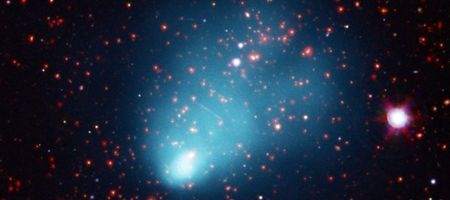Astronomers say they’ve detected the largest galaxy yet seen in the distant universe, more than seven billion light years from Earth.

Discovered using NASA’s Chandra X-ray Observatory and the National Science Foundation-funded Atacama Cosmology Telescope (ACT) in Chile, ACT-CL J0102-4915 has been nicknamed ‘El Gordo’, ‘the fat one’ in Spanish.
“This cluster is the most massive, the hottest, and gives off the most X-rays of any known cluster at this distance or beyond,” says Felipe Menanteau of Rutgers University.
The study of galaxy clusters can throw light on dark energy and dark matter, which are involved in their formation through the merger of smaller groups or sub-clusters of galaxies.
“Gigantic galaxy clusters like this are just what we were aiming to find,” says Jack Hughes, also of Rutgers. “We want to see if we can understand how these extreme objects form using the best models of cosmology that are currently available.”
El Gordo was discovered thanks to the Sunyaev-Zeldovich effect, whereby photons in the cosmic microwave background interact with electrons in the hot gas that pervades these enormous galaxy clusters.
The photons acquire energy from this interaction, which distorts the signal from the microwave background in the direction of the clusters. The scale of this distortion depends on the density and temperature of the hot electrons and the physical size of the cluster.
X-ray data shows that El Gordo is, in fact, the site of two galaxy clusters colliding at several million miles per hour, like the well-known Bullet Cluster.
As with the Bullet Cluster, there’s evidence that normal matter, mainly composed of hot, X-ray bright gas, has been wrenched apart from the dark matter in El Gordo. The hot gas in each cluster was slowed down by the collision, but the dark matter was not.
“This is the first time we’ve found a system like the Bullet Cluster at such a large distance,” says Cristobal Sifon of Pontificia Universidad de Catolica de Chile (PUC) in Santiago. “It’s like the expression says: if you want to understand where you’re going, you have to know where you’ve been.”






